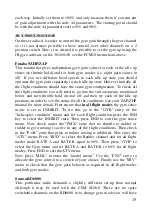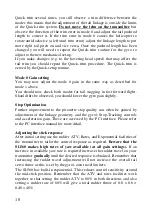
8
better performance can often be gained by mounting the gyro at the rear of
the frames.
Radio and tail linkage adjustment
In our experience most problems with gyro systems arise from incorrect
radio set-up, incorrect servo arm length, or poor adjustment of the tail
control linkage. The following sequence is designed to avoid these snags
and ensure a faultfree installation first time. You may need to consult your
radio control system manual in order to identify the receiver channels for
the rudder and gain inputs to the gyro, however we have included
information for some commonly used systems later in this manual.
Radio Set-up
First enter the menus of your transmitter and set up the rudder and gain
channels as follows:-
N
Centre rudder trims and (if fitted) rudder sub trim.
N
Set rudder travel adjustment (ATV) to 90%. Most transmitters have
separate adjustments for left and right movements and you should
make sure you have set the travel adjustment for both directions. At
this stage (i.e. before the gyro has been installed) we are using this
value to help establish the right servo arm length. Once the gyro has
been installed the rudder ATV is used to set the yaw rate demand.
N
Ensure that the rudder rates are set to the default value of 100%.
N
Set the gain channel travel adjustment to 60% (both ways).
N
Ensure that Automatic Tail Stabilisation (ATS) or 'REVO' mixing is
INHIBITED.
N
Ensure that pilot authority mixing is INHIBITED.
N
Put the throttle hold switch to the OFF position.
Rudder channel checks
N
At this point you should plug the rudder servo directly into the rudder
output of the receiver.
N
Turn on the radio and open and close the throttle. The rudder servo
should not move as the throttle is operated. If it does, then ATS or
REVO mixing is still active.
You will need to inhibit it before
proceeding further
. Make sure it is inhibited in all your transmitter's
idle-up states.























